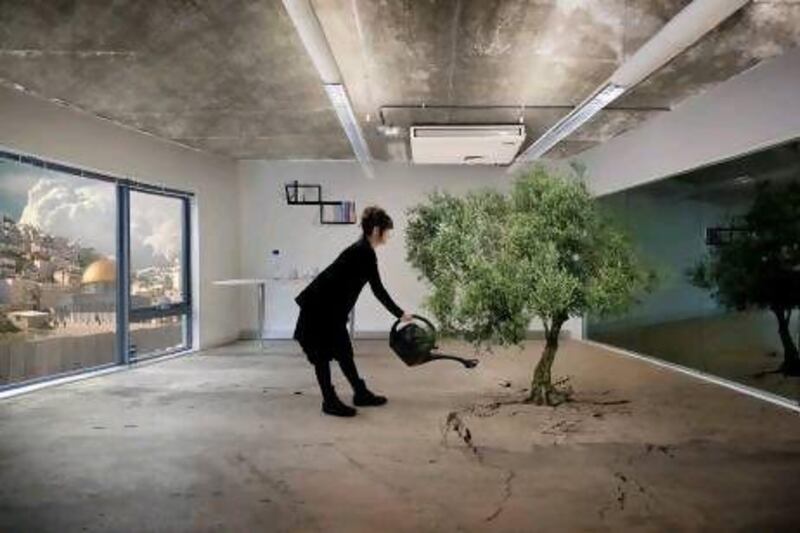There are two smart museum-like exhibitions to sink your teeth into this month at Maraya Art Centre and Barjeel Art Foundation in the waterfront area of Al Qasba, Sharjah:
Migrasophia, until May 19
Ah, the Stans – those giants of Central Asia that are home to many nomadic peoples and play host to a spectrum of ever-shifting identities.
Works by artists from, among others, Kazakhstan, Uzbekistan, Kyrgyzstan, Turkmenistan and Afghanistan are presented in a grey and suitably chilly space (thanks to the blasting air-con), in this challenging show curated by Sara Raza.
Migrasophia offers insight into a region that has clear cultural connections to the Middle East, yet exists very much in its own steppe.
Many of the artists that Raza has selected explore the transformative power of transition. The portmanteau of Migra (-tion) and Sophia (philosophy) in the show's title suggests that those whose lives are defined by migrancy take on a certain outlook, and are somehow equipped to deal with the unfixed, nation-less state of a globalised world.
The key word here is "liminal" – an intermediary state, between becoming and become, going and being. Central Asia's great political upheavals, such as the rise and fall of Soviet dominance and waves of invasion throughout history, have not only destabilised its peoples' sense of home but also any rigidity of nationhood.
Ergin Cavusoglu was born in Bulgaria to Turkish parents, and in a two-screen video work here recreates his family's crossing from Bulgaria to Turkey after the fall of communism. We see a family pushing their prized piano across a rainy border post and into a new life. With the video on permanent loop, they're condemned Sisyphus-like to repeat their passage: a fragile looking piano in search of a wall.
Erbossyn Meldibekov from Almaty, Kazakhstan, has cast contorted faces in resin. Strangers, from 2006, offers a visceral look at the effect of migration on the psyche of those in search of work.
One of the more powerful installations here is a bunker made out of stuffed shopping bags and enclosing three TVs that, visually and aurally, recreate the movement of the Trans-Siberian Express train. In this work by the Kyrgyz artists Gulnara Kasmalieva and Muratbek Djumaliev, the train teeters through brooding valleys as two old women sit in the gloom of a carriage, warbling folk songs and singing their journey into existence.
There are many more great pieces in here, including a video work by Lida Abdul documenting a group of kids in Afghanistan attaching string to the carcass of a fighter jet in the hopes of raising it like a kite.
There is a strain of bewildering academia shared by some of the works here, not to mention the text that accompanies the exhibition by Zeigam Azizov, which seems intent on confusion.
But Migrasophia is a great opportunity to see some fine works on loan and gain insight on the point where Europe and Asia overlap.
Alienation, until September 28
The premise of this broad new show at Barjeel Art Foundation is straightforward: artists barging into the barriers that are erected in society, often headfirst.
These barriers, according to the introductory text by the curator Mandy Merzaban, can be of "language, culture, religion, social, disposition, sexuality or political views" – anything that goes against the mainstream grain and defines an individual or group as alien.
Some of the featured artists approach this in blunt tones while others, sometimes, err a little on the journalistic side.
Sama Al Shaibi's dual photographs, for instance, show the dividing swathe of wall that runs through Palestine, which snakes unnaturally through the olive groves and low-rise apartment blocks that dot the hills on both sides.
Likewise, Akram Zaatari, who grew up in Saida in the south of Lebanon during the country's civil war, showcases photographed letters that the resistance fighter Nabih Awada sent to his family during his decade-long imprisonment in an Israeli prison. A grim tripartite of physical, psychological and ideological barriers are under scrutiny here.
But the best works in Alienation are those that take more of an indirect approach to this confrontational subject. Jaffar Khaldi's Go Where, one of the Palestinian artist's better works before he drifted into heavy use of a projector to create his paintings, shows off his ability to concoct a scene from disparate elements and still make it spark. The painting shows misty mountains in the background, leading down to a messily wrought lowland of forlorn bodies and thrown-together tents. Staring down at this hastily built refugee camp is an omnipotent cuboid – some ultramodernist home, with its own blue swimming pool.
Opposite Khaldi's painting is a great sculpture by Walid Siti, in which a chaos of straw ladders rise up through a wireframe of a skyscraper. Chasing Utopia may be stark, but there's some power in its analysis of material yearnings.
Manipulated photographs by Larissa Sansour also feature, from her Nation Estate series that were removed from last year's Elysee Prize by the fashion house Lacoste, a sponsor of the prize, because, according to the artist, the works were deemed "too pro-Palestinian".
Alienation is a huge show, and well curated from the collection of Barjeel's founder Sultan Sooud Al Qassemi. The 12 artists included don't so much transcend the barriers that are the show's premise, but rather try to scale them and get some perspective on how the land actually lies.





